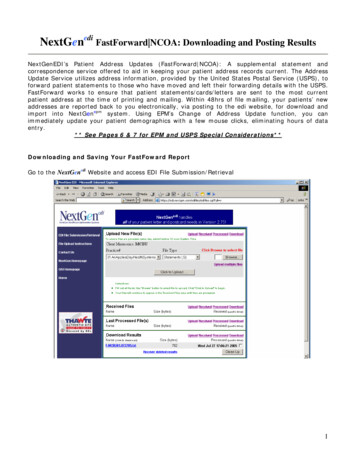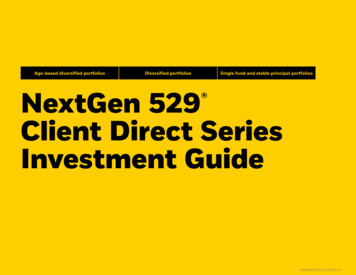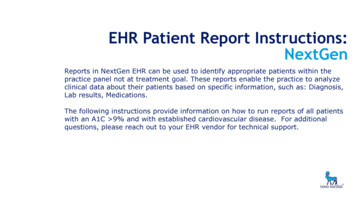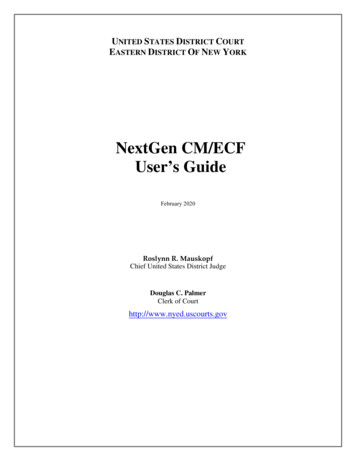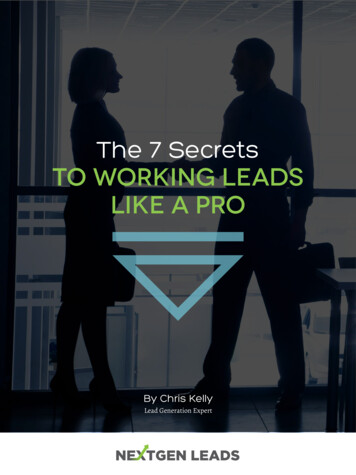
Transcription
The 7 Secretsto working leadslike a proBy Chris KellyLead Generation Expert
table of contentsIntroduction1Secret 12Leads are not one size fits all. Make sure you’re buying leads that fit!Secret 2 Know the relevant metrics for your business like the back of your hand.6Secret 3 Work your leads tenaciously.10Secret 4 Don’t sound like a robot.13Secret 5 Commit to a reasonable test, but know when to move on.16Secret 6 Don’t lose the technology arms race.20Secret 7 Establish and maintain a positive relationship with your lead provider.24Next Steps28
you might be thinking.Once I take into account the cost of buying leads, all my profits are gone.I can’t afford to pay for leads.I get plenty of customers from referrals and networking.Why would I pay for leads?Leads are a rip off. I’ve triedthem before and they justdon’t work.As someone who sells leads for a living, I’ve heard these and similar statementsmore times than I can count. Many insurance professionals are convincedthat buying leads is not a viable option for them, which is surprising whenyou consider that, virtually without exception, all of the most successfulinsurance agencies in the country buy leads every single day, and derivemost of their sales from leads. So where does this disconnect come from?Why do leads work so well for some and not for others?A lot of salespeople seem to think that leads are like a magic wand: just wavethem about and wait for deals to start closing. (And if no deals materialize,it must mean the wand is busted!) But just like most things in life, buyingand working leads is a skill that has to be learned, practiced and honed. Twopeople working the exact same leads can have radically different results,with one finding a consistent source of profitable new business and the otherthrowing in the towel. The difference between success and failure lies inthe processes, sales techniques, best practices and plain old common senseemployed by the salesperson.The purpose of this eBook is to arm you with the knowledge and resourcesyou need to work sales leads effectively. Throughout this book, I will usehealth insurance leads as an example, but the secrets and techniques hereare equally applicable in any business that deals with leads. If I’ve done myjob, after reading this book you will know exactly what your next steps are tostart working leads like a pro, closing more deals, and making more money.1
secret #1Leads are not one size fits all.Make sure you’re buying leadsthat fit!One of the biggest mistakes that insurance agents routinely make is buyingthe wrong type of leads. What do I mean by that? Well, most lead vendorssell three distinct types of real-time leads.SharedLeadsExclusiveLeadsLiveTransfers1232
let’s break thesedownShared LeadsA consumer looking for health insurance fills out a form online, and severalinsurance agents (typically 3-5, but if you’re working with lower qualityvendors it can be 10 ) call the lead, hoping to be the one to pitch the consumerand close a deal. This is an “outbound” lead, meaning that you as the agenthave to call the lead yourself. Shared leads are typically the cheapest realtime lead you can buy.Exclusive LeadsThese are just like shared leads, except they are only sold to a single agent.Again, this is an outbound lead where the agent dials the consumer. Theseare more expensive than shared leads and cheaper than live transfers.Live TransfersAlso sometimes called a warm transfer, a live transfer is a lead where yourlead vendor calls the lead on your behalf, per-qualifies the lead by askingsome questions -- in the case of health insurance, these questions are likelyto center around income and medical conditions -- and then transfers thecall so that you can close the deal. This is an “inbound” lead because the callis coming in to you. Live transfers are the most qualified type of lead you canbuy, and also the most expensive.Secret #13
So which lead type is best, and whichshould you be buying?The answer is “it depends.” The general rule ofthumb is that larger agencies and call centersdo best with shared leads, independent agentsdo best with live transfers, and agents in themiddle of the spectrum might do well witheither, or with exclusive leads.Shared LeadsTypically, one of the biggest mistakes anindependent agent can make is buying sharedleads, and this makes perfect sense if youthink about the competitive nature of thislead type. A call center is usually going tohave at least 10, and in some cases over 100,people calling their leads throughout theday. They are most likely going to be usinga sophisticated automated dialer to ensurethat each lead is called the second it comes in,and called repeatedly until someone picks up.An individual agent manually dialing thesesame leads is completely outgunned, and isfar less likely to get through to the prospectthan the call center.If you’re an individualagent, don’t wasteyour time or moneyhere.Secret #1Live TransfersLive transfers really level the playing field.Since the call is coming in to you, the callcenter doesn’t have any advantage fromits numbers or technology. In fact, sinceindividual agents are more likely to beexperienced industry veterans (whereas callcenter agents are more likely to be newerand less experienced), they are more likely tocapitalize on a pre-qualified lead and closethe deal. Live transfers also don’t require youto invest in a CRM (Customer RelationshipManagement software) or power dialer, whichmakes them accessible to any salesperson.Therefore, livetransfers arethe best fit forindividual agents.Exclusive LeadsSo what about exclusive leads? Exclusive leadsare ideally suited to individual agents andsmall agencies who are looking to even outtheir workday with a constant supply of newpeople to talk to. It’s true that exclusive leadsrequire more work than live transfers sinceyou have to call the lead instead of havingthem call you, but live transfer volume isn’talways consistent. If you rely purely on livetransfers, you may have long stretches of theday where you’re just waiting for your phoneto ring, and you may not be closing enoughbusiness to keep the lights on. Exclusive leadshelp you stay busy by ensuring you alwayshave fresh prospects to call or email.4
Secret #1Section SummaryIndividual agents should start with live transfers andsupplement with exclusive leads to get more volume.Shared leads are best left to call centers.5
secret #2Know the relevant metrics foryour business like the back ofyour hand.How much money do you make on every deal? What’s the most you can affordto pay for a sale? How many people do you typically need to talk to close adeal? How long does it take you to get paid? What percentage of your “closed”deals never end up going through, or cancel after a short time? A surprisingnumber of salespeople can’t answer one or more of these questions, whichis sure death if you’re spending your hard-earned cash on leads.6
An agent relying on referrals, networking and good old-fashioned shoeleather can afford to be in the dark on his metrics because the only thingthat ignorance is costing him is his own time. But if you’re spending moneyon leads, not understanding your metrics can be very costly. Don’t worry,though: it’s pretty easy to figure this stuff out.The main things to be cognizant of areyour average Revenue Per Sale (howmuch money comes in when you makea sale) and your target or maximumCost Per Sale (how much you are willingto spend on leads to make a sale).RPSSecret #2CPS7
If you have employees or rent an office, you might haveto factor that in as well, but to keep things simple, thefollowing example is for an independent agent workingfrom home, with negligible overhead costs:Pam is a health insurance agent. In addition to selling major medical insurance,she also sells supplemental insurance (such as dental, vision, life insurance oraccident policies) and has negotiated advances with her carriers to frontloadher commission. An average deal puts about 380 in her pocket up front,with some residual income in the future. Pam’s Revenue Per Sale is therefore 380. Pam isn’t working for free, and she expects to make 200 in profit onevery sale. Her only real expense is leads, and that means that if she wantsto make 200 per sale, she needs to spend an average of 180 or less persale on leads ( 380 - 200 180). She goes to a lead vendor who quotes 5 for shared leads, 10 for exclusive leads, and 30 for live transfers. Whatclosing rate would she have to achieve on each of these lead types to hither goal?If algebra isn’t your thing, another way to pose this question is “how manyof each of these types of leads could Pam buy for 180?” Well, she couldbuy 36 shared leads, 18 exclusive leads or 6 live transfers. If she closed onedeal on each of these lead types, her Cost Per Sale would be 180, and herclosing ratio would be 1/36 or 2.8% on the shared leads, 1/18 or 5.6% on theexclusives, and 1/6 or 16.7% on the live transfers. And there’s your answer.Depending on which lead type she chooses, she would have to achieveone of the closing rates above (or better) in order to keep her cost per saleunder 180.This math isn’t hard, but it’s important that you do it so you have some idea of whether you aremeeting, or at least close to, your goals. An agent might get discouraged if she is only closing4% of her shared leads, but if each of those leads costs 4.00, her Cost Per Sale is only 100,which most lead buyers would be very happy with. On the other hand, a 30% closing rate onlive transfers might sound very good, but if each transfer costs 50, then the Cost Per Sale is 167, which might be more than you are willing to pay.Secret #28
Secret #2Section SummaryKnow how much money you make on each sale andhow much you’re willing to spend on leads to makea sale. Then, using the price of a lead, calculate theclosing rate you need to achieve to hit your goal. Forexample, if you want a Cost Per Sale of 150 or less,and you are buying live transfers for 30 each, thenyou need to close at least 20% of your transfers.9
secret #3Work your leads tenaciously.How many of your deals close on the first call? I can’t answer that questionfor you, but I can guarantee it’s less than 100%. In fact, it’s probably far lessthan 50%. But that doesn’t stop a huge number of agents from buying a bunchof leads, calling each one once, and then throwing up their hands in despairand concluding “the leads are junk” when they don’t get any sales.Estimates vary on the ideal number ofcontact attempts to make, but mostexperts agree that you should call eachlead at least six times before giving up1on it.If you’re calling your leads less than that, you’re wasting money. And yes, Idid say six times. Some experts insist you should call ten times.“But wait,” you say, “calling each lead six times is difficult and labor intensive!”Yes, it can be, but having a process helps. When a fresh lead comes in, getin the habit of calling, and if you don’t get an answer, emailing the personimmediately. It’s perfectly fine to have a template email that you just updatewith the person’s first name in order to be more efficient. If you don’t hearback, call again an hour later and keep doing it until you’ve made at least sixcall attempts.1 Ken Krogue Reveals Why Inside Sales Is All About the es/inside-sales-leads10
some advice froma proHere’s a tip that works for manysalespeople: don’t leave a voicemailuntil your final attempt on a lead.The fact is that a lot of people don’t want to talk to someone who’strying to sell them something. If you leave a voicemail and theperson decides they don’t want to talk to you, they are more likelyto recognize your phone number when you call again and not pickup. And yes, people will do this even when they just filled out arequest for the product or service you’re providing. It’s maddeningbut it happens all the time! If you don’t leave a message and justkeep calling, eventually most people will become curious and takethe call. Even if they’re a little annoyed at your persistence, you’veat least gotten them on the phone, which is a lot better than talkingto an answering machine. If you’re trying a lead for the final timeyou have nothing to lose, so you might as well leave a voicemail.As you scale up the number of leads you’re buying – and especiallyif you start hiring additional agents – you will probably find thatconsistently making the correct number of attempts on a lead isdifficult, if not impossible, without the aid of technology. This iswhy most call centers use dialing software that takes the guessworkand tedium out of calling (see Secret #6 for more on that).Secret #311
Secret #3Section SummaryIf you don’t get an answer on the first call, keepcalling back until you do. Call each lead at least sixtimes, and don’t forget to follow up with an email.Most sales do not happen on the first call!12
secret #4Don’t sound like a robot.Think about the last time you heard a really boring sales pitch over the phone,and about all the products you bought from that salesperson. Oh wait,chances are you didn’t buy anything from them, and instead hung up asquickly as possible, possibly after making a rude comment.13
It’s natural when you’re saying the same thing day in and day out that itstarts to sound a little wooden, a little forced. After all, you’re only human,and it’s very difficult to sound as excited about your pitch the 1,000th timeyou’ve said it as you did the first. But guess what?The person on the other end of the phonedoesn’t care if you’re bored. If you’re notexcited about what you’re selling, youcan be sure they aren’t going to be.Try to deliver every pitch like it’s the most important one you’ve ever made,and you couldn’t be more excited to be giving it. People will feed off yourexcitement and be much more likely to hear you out.This book isn’t about sales techniques, so I’m not going to spend too muchtime on this subject, but it’s important when buying leads that you don’t“overdose” on calling and start to sound like a robot. Break up your day bytaking frequent breaks, doing exercises at your desk and playing with yourdog. Don’t have a dog? Well, then I just feel sorry for you. Also, try splicing insome live transfers to break the monotony of always being the one makingthe call. It’s always nice to have a qualified prospect contact you! You willfind that the better your attitude is and the more energetic and positive yousound on the phone, the more sales you will close.AttitudeSecret #4EnergyPositivity14
Secret #4Section SummaryAll your lead provider can do is help you getsomeone on the phone: it’s up to you to close the deal.Treat every pitch like the golden opportunity it is,and make every conversation count. Stay positive!15
secret #5Commit to a reasonabletest, but know when tomove on.The “ten lead test” is the surest mark of a lead newbie that I know. “Now Chris,I’m going to buy ten leads from you, and if I close one I’ll know the leads aregood, and if I don’t I’ll know they’re bad.” Sorry, but no, you won’t know that.You might close three of those leads or you might close zero, but either wayyour sample size is far too small to draw any meaningful conclusions.16
leads are a numbersgameConfidenceLeads are a numbers game, and that means that the larger your numbers arethe more confident you can be in your conclusions. Someone who has bought1,000 leads from a vendor will probably have a good idea of quality (thoughdepending on the lead type, even a thousand leads can be on the low side fortesting). Someone who’s bought one or five or twenty leads will not have agood idea of quality. At such small numbers, the leads might be terrible butyou get lucky and close one, or the leads might be excellent, but your luckisn’t and you close zero.Quantity of LeadsThe point here is that you need to be willing to do a real test with a leadvendor if you want to get any kind of accurate assessment of quality. Yes,this means spending money with no assurance of success, but it’s the onlyway you can be somewhat sure whether you’ve found a good lead source ornot. To make things easier, most lead companies will offer a sign-up bonusto new customers to help them offset the cost of testing. NextGen Leads (mycompany) does this, and you can find more details at the end of the book onour sign-up bonus program.Secret #517
so how many leads isenough for a goodtest?There is no hard and fast answer to this question, and unless you have a PhDin statistics, it’s probably not worth your trouble to calculate with statisticalsignificance the actual number of leads you would need to buy to be certain oftheir quality. (And even if you did calculate that number, it’s probably muchhigher than you’re willing to spend on a test!) So how much should you spendbefore assessing quality?A good rule of thumb is to take your targetCost Per Sale (CPS) and devote 2-3 timesthat amount on testing a new source.So if your target CPS is 150, I would recommend spending 300 - 450 testinga new source. And again, depending on your sign-up bonus, your actual spendmay be quite a bit less than this.After spending this amount, look at how the leads performed. If you closed oneor two deals from your test, you might be fairly close to your target CPS, and aconversation with your account executive (see Secret #7 below for more on that)is likely to help you get to your goal. If you’ve closed 3 or more deals, there’s agood chance you’ve found a solid lead source, though you’ll want to wait untilyou have a larger sample size before you can be sure of that conclusion. If youhaven’t closed any deals, let your account executive know. If they don’t offerany insight or help, consider cutting your losses and moving on.Secret #518
Secret #5Section SummaryOnce you’ve decided to try a lead source, committo a reasonable test so you can get an accurateassessment of quality. A good rule of thumb is todevote 2-3x your target CPS to a test. If the resultsare dismal after committing that amount, only thenshould you consider moving on.19
secret #6Don’t lose the technologyarms race.This section is really aimed at people who are a little more advanced in theirlead buying than the average agent, but I think every salesperson shouldaspire to reach the point where the technology arms race becomes relevant,so even if you’ve never bought a single lead, please read on!Pretty much everyone who buys leads starts out the same way: they sign upfor an account with a lead provider, set up a campaign, and start buying afew leads at a time with the leads delivered to their email address. When alead comes in, the salesperson picks up his phone and starts dialing. If hedoesn’t get an answer, and he’s smart, he tries again every hour or so untilsomeone picks up. Rinse and repeat, pretty simple.20
This is all well and good if you’re an individual agent buying a few leads aday. But what if you’re buying a lot of leads, say more than ten a day? What ifyou aren’t just buying leads for yourself, but for an entire sales floor of five,ten or even 100 people? Do you think the scenario I laid out above will work?In case you’re wondering, the answer is no, it won’t.At some point as you scale your business, you will need to leverage technologyto help you stay organized and efficient. At the very least, you’re going to wanta basic CRM (Customer Relationship Management) and a calendar program.CRMs range in price from cheap or free to quite expensive, and calendarsare pretty much always free (I use Google Calendar which is free and workswell).If you’re just starting out, a bare bones CRM should be just fine. All youreally need is a place to store your leads, make notes, update contacts as they(hopefully) progress toward becoming a sale, and keep track of appointments.Most lead vendors should be able to easilyintegrate with your CRM, which meansthey can send your leads directly to yourCRM without you having to manuallyenter them in.Make sure you do this! It is incredibly important that you have one centralplace where you can go to quickly look up all your leads and take action onthem as necessary.Secret #621
But what if you’re buying dozens or hundredsof leads per day, and you have several peoplecalling them? How do you know if a lead hasn’tbeen called yet, or conversely, if it’s beenaccidentally called 20 times in 20 minutes?How can you be sure that you’re callingthe leads the correct number of times at areasonable interval, and that nothing isfalling through the cracks? And maybe mostimportantly, how do you keep your fingersfrom falling off with all the dialing you’redoing? This is where a power dialer comesin. A power dialer is a piece of software thatautomatically dials your leads following rulesyou specify, makes sure each lead is dialed thecorrect number of times, and tracks the statusof your leads. In many ways, a power dialeris similar to a CRM (and in fact, pretty muchall of them include basic CRM features), buta power dialer goes further in that it actuallydials your leads for you.For example, you can set your power dialer toautomatically dial a lead the second it comesin, and keep dialing it once an hour until you’vedialed it six times. You can set your dialer tosort the list of leads you’re dialing so that theones that came in most recently or the onesthat have been dialed the least number of timesget priority. In this way, you can efficientlychurn through an enormous number ofleads while being sure that you are dialingas efficiently and thoroughly as possible.Secret #6Obviously, in order to do this, it’s importantthat your lead vendor sends your leads directlyto your dialer (side note: NextGen Leads caneasily integrate with any dialer software). It iscritical that you do this, because if you don’tyou miss out on one of the biggest benefitsof using a dialer: the ability to immediatelydial a lead the second it comes in.Dialing leads thesecond theycome in is whybig agencies do sowell with sharedleads and areable to outgunindependentagents.A you might have guessed, dialers are notcheap. Some have a monthly subscriptionmodel and others have no monthly cost, butrequire a significant investment upfront toinstall. If you go the latter route, go on Yelp orleverage your network to find a reputable ITprofessional to install it for you, and makesure they will be available for follow upquestions and consultation because you willhave questions. (Dialers aren’t simple, either!)22
Secret #6Section SummaryIf you’re buying more than half a dozen leads aday, invest in a (cheap or free) CRM at the very leastto help you stay organized. If you want to grow anagency or call center, invest in a power dialer, andif you go the Do-It-Yourself route, invest in agood IT professional as well!23
secret #7Establish and maintain apositive relationship withyour lead provider.Lead vendors are people too! Lead generation is an industry that many (oftenfairly) see as dishonest and dirty, but when you paint all lead generators withthe same brush you do them and yourself a disservice. Oftentimes it feelsthat new customers who have had a negative experience with another leadvendor are looking for a reason for things to go wrong, maybe to confirmtheir own biases, and sure enough that’s usually what happens when they goin with that attitude.24
we want you tosucceedThe fact is that lead generators couldn’t stay in business unless ameaningful number of customers were seeing success with theirleads. So instead of approaching a new lead generator with a negative“this will never work” attitude, try to make an earnest effort to makethe relationship successful. Tell your account executive what youare trying to accomplish, and what your metrics for success are(Secret #2), so they can help you reach your goals. More often thannot, they will be able to provide insight and advice on how to usetheir platform to better achieve your goals.They want you to succeed with theirleads because they know you willkeep buying if you do, so try to thinkof the relationship as a partnership,where success means both sidesare coming out ahead.YOUSecret #7US25
Building a strong relationship with your lead vendor also meansgiving frequent feedback, both positive and negative, so they knowwhat’s working and can course correct where necessary. If you’vejust finished a test and the numbers aren’t quite where you needthem to be, let your account executive know.They might be able to offer you anadditional bonus, discount or someother help to get you to where youneed to be.If you have a really good week with the leads, share that as well, sothe lead vendor can look at their data and try to increase volumeon their best performing sources.Keep in mind that this is a two way street. If you start complaininga lot after doing a “ten lead test” or express frustration when everysingle lead you buy doesn’t turn into a deal, you might discourageyour account executive from trying to help you. They may concludethat it is not worth their time to try to grow your account, and thatmeans they’re less likely to reach out to you with promotions, adviceand new features. The more respect you give, the more you willget, and it is always in your best interest to have a strong, positiverelationship with your account executive.Secret #726
Secret #7Section SummaryMaintain a positive relationship with your leadvendor and your account executive especially. Thebetter your relationship, the more likely they areto make the extra effort to ensure that your leadcampaign performs exceptionally.27
next stepsIf you’ve gotten this far, chancesare you’re pretty serious aboutworking leads like a pro. Great!Here’s what you should do next.1(Shameless self-promotion alert!)Sign up for an account at nextgenleads.com.You will be assigned a dedicated account executive who will provide youwith a free consultation, and help you design a lead campaign that fitsyour needs.2Decide whether you want to buy shared, exclusive, or live transfer leads. Forindividual agents and small agencies, the best approach is typically to startwith live transfers and supplement with exclusive leads. If you have a lot ofagents working your leads, shared leads will probably yield the lowest CostPer Sale (CPS).3Commit to a meaningful test. At the bare minimum, you should spend 2-3times your target CPS before drawing any conclusions about quality.4Establish a strong relationship with your account executive, and providefrequent detailed feedback so she can provide you with the best service possible.5If you’re doing well with leads and you want to scale up (and maybe even hireadditional sales staff to help you work your leads), invest in a CRM and/ordialer. This is the only way to stay organized as you expand, and ensure thatyou’re getting the highest Return On Investment on your leads.28
From the Author:I hope you found this book useful.If you have, and you want to startworking high quality leads like apro, I encourage you to sign up for an accountat nextgenleads.com. Our job is to help yougrow your business, and we love what we do!Chris Kelly is an expert in online advertising and lead generation.After starting his career at Google, he went on to form a highlysuccessful online advertising company and an insurance agency.He is the co-founder and CEO of NextGen Leads.29
Introduction Secret 1 Leads are not one size fits all. Make sure you're buying leads that fit! Secret 2 Know the relevant metrics for your business like the back of your hand. Secret 3 Work your leads tenaciously. Secret 4 Don't sound like a robot. Secret 5 Commit to a reasonable test, but know when to move on. Secret 6 Don't lose the technology arms race.



